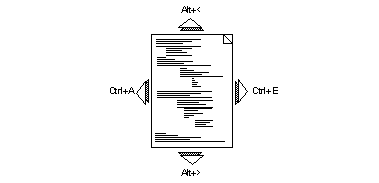






This section describes how you can move the cursor around the buffer. There are a variety of commands, allowing you to move sideways, up, or down by one character, or by a number of characters.
To move directly to any point in the buffer, position the pointer and click the left mouse button. If necessary, use the scroll bars to reveal sections of the buffer which are not visible in the window.
You can either use the arrow keys, or the keyboard commands shown below to move the cursor in any direction by one character.
Figure 13.10 Moving the cursor by one character


The keyboard commands below move to the beginning or end of the line, or the top or bottom of the buffer.
Figure 13.11 Keyboard commands for basic movement within an editor buffer


Press
Ctrl+V
or the
Page Down
key to scroll down one screenful of text.
Press
Esc V
or
Alt+V
or the
Page Up
key to scroll up one screenful of text. Note that Page Up is accessed by pressing the
fn
key together with the
Up
arrow key.
You should ensure that you learn the keyboard commands described above, since they make navigation in a buffer much easier.